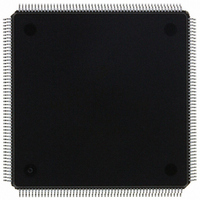MCF5307AI90B Freescale Semiconductor, MCF5307AI90B Datasheet - Page 207

MCF5307AI90B
Manufacturer Part Number
MCF5307AI90B
Description
IC MPU 32BIT COLDF 90MHZ 208FQFP
Manufacturer
Freescale Semiconductor
Series
MCF530xr
Datasheets
1.MCF5307AI66B.pdf
(484 pages)
2.MCF5307AI66B.pdf
(16 pages)
3.MCF5307AI66B.pdf
(2 pages)
Specifications of MCF5307AI90B
Core Processor
Coldfire V3
Core Size
32-Bit
Speed
90MHz
Connectivity
EBI/EMI, I²C, UART/USART
Peripherals
DMA, POR, WDT
Number Of I /o
16
Program Memory Type
ROMless
Ram Size
4K x 8
Voltage - Supply (vcc/vdd)
3 V ~ 3.6 V
Oscillator Type
External
Operating Temperature
0°C ~ 70°C
Package / Case
208-FQFP
Maximum Clock Frequency
90 MHz
Maximum Operating Temperature
+ 105 C
Mounting Style
SMD/SMT
Minimum Operating Temperature
0 C
Family Name
MCF5xxx
Device Core
ColdFire
Device Core Size
32b
Frequency (max)
90MHz
Instruction Set Architecture
RISC
Supply Voltage 1 (typ)
3.3V
Operating Temp Range
0C to 70C
Operating Temperature Classification
Commercial
Mounting
Surface Mount
Pin Count
208
Package Type
FQFP
Program Memory Size
8KB
Cpu Speed
90MHz
Embedded Interface Type
I2C, UART
Digital Ic Case Style
FQFP
No. Of Pins
208
Supply Voltage Range
3V To 3.6V
Rohs Compliant
Yes
Lead Free Status / RoHS Status
Lead free / RoHS Compliant
Eeprom Size
-
Program Memory Size
-
Data Converters
-
Lead Free Status / Rohs Status
Lead free / RoHS Compliant
Available stocks
Company
Part Number
Manufacturer
Quantity
Price
Company:
Part Number:
MCF5307AI90B
Manufacturer:
FREESCAL
Quantity:
153
Company:
Part Number:
MCF5307AI90B
Manufacturer:
Freescale Semiconductor
Quantity:
10 000
Part Number:
MCF5307AI90B
Manufacturer:
FREESCALE
Quantity:
20 000
- Current page: 207 of 484
- Download datasheet (6Mb)
determines the relative priority of competing devices. A device loses arbitration if it sends
logic high while another sends logic low; it immediately switches to slave-receive mode
and stops driving SDA. In this case, the transition from master to slave mode does not
generate a STOP condition. Meanwhile, hardware sets I2SR[IAL] to indicate loss of
arbitration.
8.4.2 Clock Synchronization
Because wire-AND logic is used, a high-to-low transition on SCL affects devices
connected to the bus. Devices start counting their low period when the master drives SCL
low. When a device clock goes low, it holds SCL low until the clock high state is reached.
However, the low-to-high change in this device clock may not change the state of SCL if
another device clock is still in its low period. Therefore, the device with the longest low
period holds the synchronized clock SCL low. Devices with shorter low periods enter a high
wait state during this time (See Figure 8-4). When all devices involved have counted off
their low period, the synchronized clock SCL is released and pulled high. There is then no
difference between device clocks and the state of SCL, so all of the devices start counting
their high periods. The first device to complete its high period pulls SCL low again.
8.4.3 Handshaking
The clock synchronization mechanism can be used as a handshake in data transfers. Slave
devices can hold SCL low after completing one byte transfer (9 bits). In such a case, the
clock mechanism halts the bus clock and forces the master clock into wait states until the
slave releases SCL.
8.4.4 Clock Stretching
Slaves can use the clock synchronization mechanism to slow down the transfer bit rate.
After the master has driven SCL low, the slave can drive SCL low for the required period
and then release it. If the slave SCL low period is longer than the master SCL low period,
the resulting SCL bus signal low period is stretched.
SCL1
SCL2
SCL
Freescale Semiconductor, Inc.
Figure 8-4. Synchronized Clock SCL
For More Information On This Product,
Internal Counter Reset
Go to: www.freescale.com
Chapter 8. I
2
Wait
C Module
Start counting high period
I
2
C Protocol
8-5
Related parts for MCF5307AI90B
Image
Part Number
Description
Manufacturer
Datasheet
Request
R
Part Number:
Description:
Manufacturer:
Freescale Semiconductor, Inc
Datasheet:
Part Number:
Description:
Mcf5307 Coldfire Integrated Microprocessor User
Manufacturer:
Freescale Semiconductor, Inc
Datasheet:
Part Number:
Description:
Manufacturer:
Freescale Semiconductor, Inc
Datasheet:
Part Number:
Description:
Manufacturer:
Freescale Semiconductor, Inc
Datasheet:
Part Number:
Description:
Manufacturer:
Freescale Semiconductor, Inc
Datasheet:
Part Number:
Description:
Manufacturer:
Freescale Semiconductor, Inc
Datasheet:
Part Number:
Description:
Manufacturer:
Freescale Semiconductor, Inc
Datasheet:
Part Number:
Description:
Manufacturer:
Freescale Semiconductor, Inc
Datasheet:
Part Number:
Description:
Manufacturer:
Freescale Semiconductor, Inc
Datasheet:
Part Number:
Description:
Manufacturer:
Freescale Semiconductor, Inc
Datasheet:
Part Number:
Description:
Manufacturer:
Freescale Semiconductor, Inc
Datasheet:
Part Number:
Description:
Manufacturer:
Freescale Semiconductor, Inc
Datasheet:
Part Number:
Description:
Manufacturer:
Freescale Semiconductor, Inc
Datasheet:
Part Number:
Description:
Manufacturer:
Freescale Semiconductor, Inc
Datasheet:
Part Number:
Description:
Manufacturer:
Freescale Semiconductor, Inc
Datasheet:











